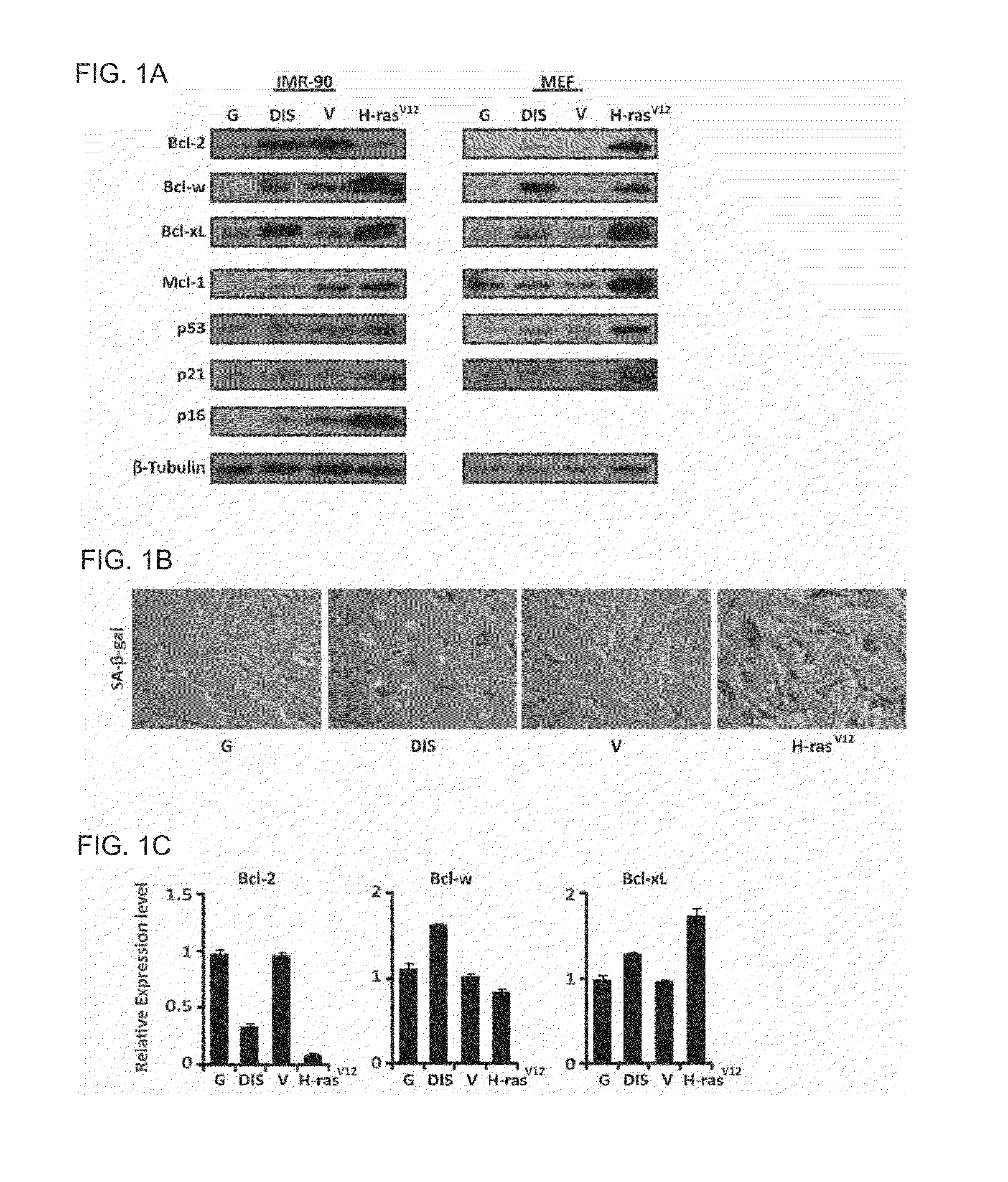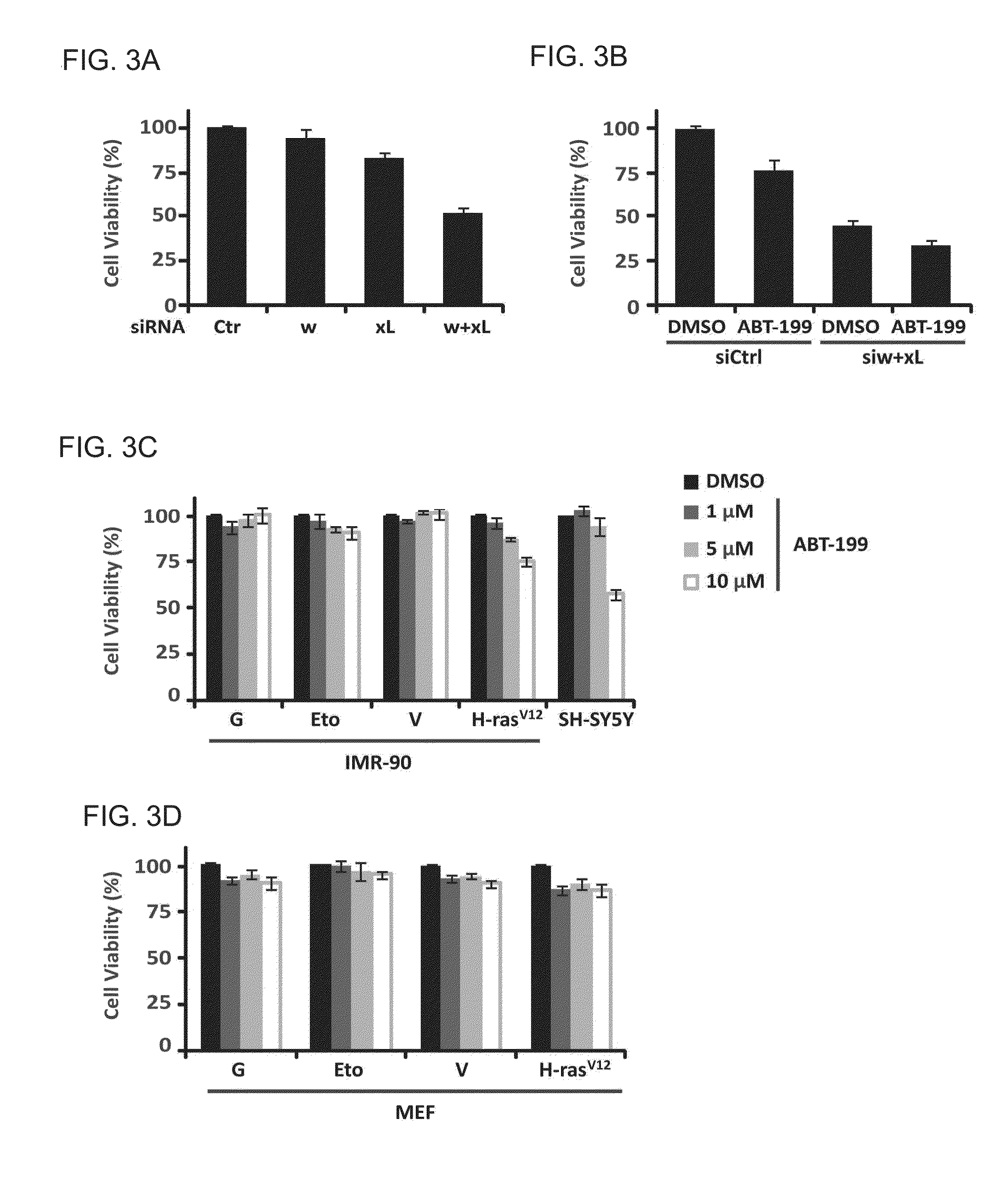Agents for downregulation of the activity and/or amount of bcl-xl and/or bcl-w
a technology of bcl-xl and bcl-w, which is applied in the direction of cardiovascular disorders, drug compositions, peptide/protein ingredients, etc., can solve the problem of unfavorable tissue fate prediction
- Summary
- Abstract
- Description
- Claims
- Application Information
AI Technical Summary
Benefits of technology
Problems solved by technology
Method used
Image
Examples
example 1
Expression of Bcl-w and Bcl-xL Proteins is Elevated in Senescent Cells
[0250]Protein levels of Bcl-2 family members in growing and senescent normal human (IMR-90) and mouse (MEF) diploid fibroblast cells were analyzed. Senescence was induced in these cells either by expression of oncogenic H-rasv12 or by treatment with the DNA damaging agent Etoposide. Bcl-w and Bcl-xL levels were elevated in senescent cells of both human and mouse origin. This effect was unrelated to the stimulus that was used to induce senescence (FIG. 1A). In contrast, the changes in Mcl-1 and Bcl-2 levels were either less pronounced or dependent on cell origin and the stress stimuli used to induce senescence. The levels of classical markers of senescence p16, p21 or p53, serve us as positive controls for senescent phenotype of the cells, together with positive SA-β-gal staining (FIG. 1A-B). Of note, the levels of mRNA of these genes were not considerably altered between growing and senescent cells, indicating tha...
example 2
Combined Knockdown of Bcl-w and Bcl-xL Induces Death of Senescent Cells
[0251]In order to distinguish which of the three proteins, Bcl-2, Bcl-w and Bcl-xL provide the apoptotic resistance of Etoposide treated senescent IMR-90 cells, the present inventors attempted to specifically inhibit the function of each of these proteins individually. siRNA was used to knock down Bcl-w and Bcl-xL, and a specific inhibitor, ABT-199, to block Bcl-2 as siRNA was ineffective in knocking down this gene on the protein level (FIG. 2B). Knocking down Bcl-w and Bcl-xL separately in senescent cells led to minor reduction in their viability (FIG. 3A). Interestingly, a combined knock-down had a synergistic effect, bringing about the demise of 50% of the cells. To assess the additive contribution of Bcl-2 inhibition on top of Bcl-w and Bcl-xL knockdown, the Bcl-2 inhibitor, ABT-199 was used (FIG. 3B). Inhibition of Bcl-2 had a statistically significant, but minor additive effect to that of Bcl-w and Bcl-xL o...
example 3
The BH3 Mimetic ABT-737 Induces Cell Death of Senescent Cells
[0252]To further test the hypothesis that an increase in the levels of anti-apoptotic proteins Bcl-w and Bcl-xL could account for the apoptotic resistance of senescent cells by an independent approach, cells were treated with the pharmacological inhibitor of the Bcl-2 family of proteins, ABT-737 (Chauhan et al., 2007). Normal human (IMR-90) and mouse (MEF) fibroblasts were induced to undergo senescence by the induction of DNA damage or by transduction with oncogenic H-RasV12. After the senescence phenotype had been established, cells were treated with ABT-737 for 24 hours. Growing, vehicle treated, or vector transduced cells served as control for DNA damage or oncogenic H-Rasv12 respectively. This treatment reduced the viability of senescent cells by 50%, while only having a minor effect on control cells (FIGS. 4A-B). Therefore, it has been shown that pharmacological inhibition of Bcl-2 family proteins leads to specific el...
PUM
| Property | Measurement | Unit |
|---|---|---|
| pharmaceutical composition | aaaaa | aaaaa |
| endogenous nucleic acid | aaaaa | aaaaa |
| cellular stress | aaaaa | aaaaa |
Abstract
Description
Claims
Application Information
 Login to View More
Login to View More - R&D
- Intellectual Property
- Life Sciences
- Materials
- Tech Scout
- Unparalleled Data Quality
- Higher Quality Content
- 60% Fewer Hallucinations
Browse by: Latest US Patents, China's latest patents, Technical Efficacy Thesaurus, Application Domain, Technology Topic, Popular Technical Reports.
© 2025 PatSnap. All rights reserved.Legal|Privacy policy|Modern Slavery Act Transparency Statement|Sitemap|About US| Contact US: help@patsnap.com



